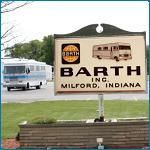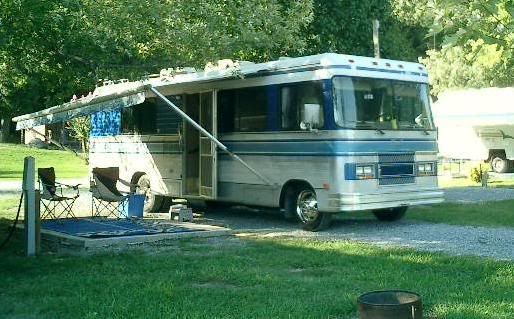Go to...  | Start A New Topic  | Search  | Notify  | Tools  | Reply To This Topic  |  |
 6/17 6/17 |
At the RV show in West Spfld MA, A sales rep from Amsoil claimed that by adding their additional oil filter, which filters particles down to one micron, you loiterally don't have to change your oil again. I'm somewhat sceptical about his claims. Has anyone with a Barth ever heard about this additional oil filter system and does it really work? Thanks, Rick R.P.Muise 1994 Breakaway/Cummins 5.9/Allison transmission/Spartan Chassis | ||
|
"Host" of Barthmobile.com 1/19 1/19 |
Some tractor trailer trucks have systems "like this" as an add on. One system even has a "dripper" that automically drips the oil into the fuel tank - it looks a little like a "I.V. Drip" at a hospital. You only add motor oil every now and then. Think about it - you change the regular filter every 85,000 to 125,000 miles and you keep adding oil to the system - in that amount of time you add 10 gallons motor oil back to the engine and you've got an additional 70 - 90 miles (burnt motor oil) free without paying a disposal fee or road use taxes. It's a win, win for everyone (including me) but the tax man! They have automatic greasers that grease everything but the driveshaft - there are automatic brake adjusters - automatic clutch adjusters - The only thing you need a mechanic for is to change the fuel filter and grease the driveshaft every 20,000 miles and then at 100,000 + miles the oil filters and separator screen, water filter and refill the greaser. There is one additional filter attached to the dripper device. The motor oil is "spun out" at high RPM in a centrifuge type device and that has a mesh type of screen in it that needs to be cleaned.
| |||||||||||||||
| ||||||||||||||||
| First Month Member |
Rick, Momma said if you cain't say nothin' good about a company, don't say nothin'. I use and recommend a bypass system using the Baldwin B164 bypass filter element. It costs under $10. It filters to 2 microns and has its own .060" orifice. It is just over 7 inches long. I replace it when it is almost clogged. That is, no longer hot to the touch, just warm. It has 5/8 18 threads, and fits a Baldwin OB1305 base, which is around $20 and has a flat flange for easy mounting. It accepts 1/8 NPT hose fittings. Any good fleet truck supply will have the filter and be able to order the base. I use Fleet Supply or Fleetpride. If your idle oil pressure drops alarmingly with the .060 orifice, you can go down to .040 or .030 by soldering a fitting on the pressure hose shut and drilling it to size. My preference is to have the restriction on the pressure end of the hose. That way, if a hose fails, there will be a smaller leak. Baldwin is a known and respected filter company who make their own products and make only verifiable claims. They devote most of their budget to research, engineering and manufacturing. Very little of their budget goes to advertising or pyramid schemes. They make all their own products, too. None are repackaged from other suppliers. All their dealers are known and respected in the industry and their communities, not opportunists operating from the trunks of their cars. Every legitimate comparison test of filters, oil and air, has Baldwin near the top. There are other bypass filters out there besides Baldwin, but do your research, as many do not filter down to 2 microns. OK, since we are on oil filters, now I've got post-itis. Here is some info on my favorite oil filter for Chevy 454s: From Chevrolet: 25013454 Synthetic Oil Filter The AC PF-35L heavy-duty spin-on oil filter can replace any PF-25 or PF-35 filter on 1968 up Chevrolet V8 engines. It has a 100% synthetic element that is rated at 12 microns. Its synthetic glass filter media provides finer filtration than conventional cellulose (paper) filters. The individual strands of synthetic glass used in the PF35L are smaller and more consistent in size than cellulose fibers. These glass fibers are supported by a polyester sheet laminated on both sides, and the pleated synthetic filter element is backed by a metal screen. This extremely efficient filter can reduce engine wear by 75% compared to conventional filters without restricting the flow of oil. From an unknown site: This is the same diameter oil filter as the PF25 (standard 350 ci engine) filter, except it is longer. The standard one filters down to 30 microns, which means any particles 29 microns or smaller will continue to circulate. The PF35L has synthetic filter element which filters down to 12 microns which means 11 microns or smaller is the circulating chunk size. Because the filter is larger, it requires almost an extra 1/2 quart of oil to be added to crankcase. This longer filter fits and aligns flush with oil pan on 305 and 350 cubic inch engines in the the 3rd and 4th generation F-bodies, so there's little risk of having it bottom out on bumps. But BEWARE if you have a 1995 model with an oil cooler housing since GM redesigned the '95 cooler which causes the PF35L to hang slightly below the oil pan thereby taking the risk that it may hit the ground on bumps and dips. No 1996 or later models got a cooler so there should be no problem there. Quote from Hot Rod: "FILTER TIP" "Chevy's new V8 heavy-duty "race" oil filter (GM 25013454 or AC PF-35L) can replace any PF-25 or PF-35 filter. Its 100-percent synthetic element is rated at 12 microns and is so efficient that engine wear is reduced by 75-percent in comparison to conventional filters-all without restricting oil flow. (Courtesy Cone Chevrolet.)" From Terry Quinn (tquinn@heartland.bradley.edu): "The following information is not specific to the PF35L, but I'm hoping that it applies. A few years ago, we were working with a filter manufacturer that was promoting synthetic (glass fiber) powertrain oil filters. They had extensive data on the difference between that type of filter and a conventional paper filter.Ø While the synthetic filter is rated for smaller particle collection, that is not the only significant advantage. When filters are rated, they frequently do a so-called "multi-pass" test. I don't remember all the particulars, but contaminated oil is circulated through the filter, under constant flow, a number of times, and the amount of particle removal or collection (cannot remember which way it is tested) after a specified number of passes, determines the micron rating. All the dirt is not removed in one pass. This standard steady state test, with a constant flow, does not tell the whole story, however. What this filter company demonstrated was that when a filter is subjected to pressure or flow surges (such as when starting with cold oil, or even as the flow changes), the filter media will flex. Paper media will then tend to release some of the contaminants back into the flow stream, in a process termed "desorption The standard multipass test will not show this to be a problem, but the release of the contaminants was very significant, and negated much of the advantage of the filtration. The glass fiber media was much more resistant to desorption than the paper media. It also took out more of the contamination in the first pass. But was also considerably more expensive. My employer, Caterpillar, then co-developed a filter with a patented spiral wrap strap around the media to prevent flexing and desorption. So, lacking the ability to use a Caterpillar filter (I don't yet have one of our 10.2 liter diesels in my 93 T/A :-), I'm using the PF35Ls with great confidence that they will make a big difference in engine life." ................................................................ NOTA BENE: I have read about offshore suppliers of the Delco PF35L or counterfeit items. Be sure they are from a reputable supplier and are made in USA. The suspect filters are much lighter and generally less sturdy appearing, and don't have the readily visible spot welds on the top. Any questions, I will provide a picture of the good ones. bill h Here is an interesting site on oil filters: http://minimopar.knizefamily.net/oilfilterstudy.html For my non-Chevy vehicles, I use a Purolator Pure 1 or Mobil 1 filter. And a cow magnet in the pan. . 84 30T PeeThirty-Something, 502 powered | |||
|
"Host" of Barthmobile.com 1/19 1/19 |
Try this link for more info... http://www.amsoil.com/StoreFront/bf.aspx   
| |||||||||||||||
| ||||||||||||||||
Captain Doom |
I'm not sure the constituents of contemporary diesel motor oil, but for years the common ash-type detergent-dispersents were barium or calcium salts - finely divided particles of the solid. Filters with <5 micron were NOT recommended because they would filter out the detergent! From the More Info Than You Really Wanted to Know Department: Detergents generally fall into two classes, ash-type and ashless. The former is a finely ground powder, the latter a liquid. Ash-type detergents react chemically with contaminants, neutralizing them, and the resulting particle is larger than the original ash particle (releasing usually a small quantity of water), and so the filter can stop it. Ashless detergents are attracted chemically to the contaminants and coat them to prevent their coming into contact with engine parts; they also coat the engine parts into which they come into contact, providing a protective barrier. Regarding any of the aftermarket filters: I'd be skeptical about the claims of "never changing one's oil again". What about the contaminants that aren't filtered out? What about fuel dilution over time in diesels (fuel won't be filtered out nor evaporated)? What about depletion of the additive package? And since many are bypass filters, what about the oil that doesn't get filtered? My opinion is that even the add-on bypass systems may provide a benefit, but I'd be wary of any miracle claims. Oil is still cheaper than metal... Rusty '94 28' Breakaway: MilSpec AMG 6.5L TD 230HP Nelson and Chester, not-spoiled Golden Retrievers Sometimes I think we're alone in the universe, and sometimes I think we're not. In either case the idea is quite staggering. - Arthur C. Clarke It was a woman who drove me to drink, and I've been searching thirty years to find her and thank her - W. C. Fields | |||
|
 4/09 4/09Founder and Moderator Emeritus  |
Wow, not to dilute the thread here, but it would seem that if someone spent two years on this website they should earn a degree of some type. Bachelors of Barth..........  | |||
|
Oil filters, analysis, etc. must have several million hits on the web. This can become a hot subject real quick, so I'll jump in with my 2 cents and duck. I've got a Cummins 8.3 and am using the Gulf Coast Filter http://www.gulfcoastfilters.com model O-1 in a bypass arrangement. I use a roll of Bounty heavy duty paper towels as the filter. GCF also has a dense cellulose filter that is usable instead of the paper towel roll. When I first stopped in to check into the setup, one of the owners told me they had to come up with the commercial filter because some of their government customers didn't like the paper towel idea, but individuals owners basically just use the paper towel insert. Also, at the next oil change I will be replacing the primary filter and will change from the standard Fleetguard LF3000 primary oil filter to the newer LF9009 that filters down to 5 microns. Before I do anything I take a sample of the oil (from a tap just before it enters the primary oil filter) and send it off to a lab ($19.50 each time). I get the results back, verify it still says the oil is OK (there is a bunch of stuff on the report), then change the roll of Bounty in the GCF filter and add 6 new quarts of Delo 400 (that's how much is tossed when the filter is removed). When I first started, I was due for an oil change and instead installed the GCF filter and added 6 qts. - in other words, I started with oil due to be changed plus 6 new quarts. 7,960 miles later I took a sample and it came back saying the oil was ok. (I had been holding my breath a little during that time.) Next two changes were also good analysis results and I just changed the GCF filter and added the makeup oil. I'm about to do one of these changes and have been chewing on switching to synthetic - with a full oil change of course. Also will do the change to the newer Fleetguard primary filter. The coach is the only vehicle I own that is not on Mobil 1. I've shown the test analysis reports to the local Cummins guy and he agrees that the results look good. I also got myself a TMEH1 oil analysis tester. I periodically use it to check all 5 of our vehicles and keep track of the results in a spreadsheet. I use a lot less oil now. The Mobil 1 15K stuff easily hits that mark before the TMEH1 starts to move much higher in its results indicating the oil is getting closer to requiring replacement. I'm not recommending any of this stuff, just telling you what I use. Mike | ||||
|
 6/12 6/12Formally known as "Humbojb"  |
My 85 Regal 454 already had a dual Amsoil system and all I know is that our oil consumption is about 1/2 a quart in 1000 miles. Wouldn't you want to change the oil at least yearly no matter how many miles you drove? Jim
| ||||||||||||
|
Nope. There are two basic reasons for using the external bypass setup. One is to get better filtration by getting suspended stuff out and the other is to not have to throw away the resulting perfectly good oil. The only problem is the additive depletion and by replacing (in my case) with 6 qts of new oil, the additives are replenished sufficiently. The lab tests seem to bear this out after nearly 4 years of use in my coach. Mike | ||||
|
"...My opinion is that even the add-on bypass systems may provide a benefit, but I'd be wary of any miracle claims. Oil is still cheaper than metal..." Amen, Bro. I'm with you. "You are what you drive" - Clint Eastwood | ||||
|
Captain Doom |
The additive package usually contains dual-purpose additives, i.e., ones that neutralize contaminants and provide other worthwhile features, such as anti-scuff and cleansing. Two of the lab test results on which you should especially keep an eye are the pentane and benzene insolubles. It's also important to get from the oil's manufacturer guidelines on interpreting the presence of elements used in the additive package. BTW, the full-flow OEM filter system also removes only suspended contaminants, as those are the only ones passing through any filter. Other contaminants or products of base stock deterioration, if the additive package is depleted, show up as varnish, sludge, or other types of deposits. The bypass filter provides additonal filtering capacity, but nothing that the OEM system doesn't do. Rusty '94 28' Breakaway: MilSpec AMG 6.5L TD 230HP Nelson and Chester, not-spoiled Golden Retrievers Sometimes I think we're alone in the universe, and sometimes I think we're not. In either case the idea is quite staggering. - Arthur C. Clarke It was a woman who drove me to drink, and I've been searching thirty years to find her and thank her - W. C. Fields | |||
|
Maybe I should have clarified one of my statements a little more. "...better filtration by getting suspended stuff out..." should have read "...better filtration by getting smaller suspended stuff out..." Seems most of the better oil filters filter down to somewhere in the 10-20 micron range but severe wear still takes place when there's junk in the oil bigger than 5 microns. Cummins recognized this formally in their extended oil change intervals when they spec out that for the latest extended service intervals, they now require the newer 5-micron filters they released a few years ago in order to take advantage of those intervals. (Hence my impending switch from LF3000 to LF9009.) The new filter was the second step in extending their change interval. First step was switching to specific oils with newer specs to handle longer intervals. Third was a requirement for an oil reservoir to replenish oil as the on-board sensors determined the on-board oil was getting 'worn out' and was slowly being injected into the fuel flow to be burned off and replaced from the reservoir - all under computer control. An immediate advantage to adding the GCF filter that I picked is 6 quarts of increased oil capacity - helps with the oil cooling and also simply gives you longer total additive life. When I originally considered adding the bypass filter, I wasn't so much concerned with extending the oil change interval as I was with the thought that soot and other small 'stuff' 5 - 10 micron size was building up in the oil and continually got worse until the oil was dumped for new. My son was the one that pointed out that those 'chunks' heading for the turbo were probably the reason the previous owner had to replace the turbo when the bearings locked up. If I had known about the newer LF9009 filter, I probably would have just settled for switching to it. Rusty, your statement: "Two of the lab test results on which you should especially keep an eye are the pentane and benzene insolubles." I don't see either of these called out on the lab report I get. I've sent off an e-mail to ask about them. Mike | ||||
|
"Host" of Barthmobile.com 1/19 1/19 |
Regarding the turbo - most people do not follow the OEM recommendation for 2-3 minutes of idle cool down time before shutting off your engine. The oil is getting "cooked" inside of the turbo and this gives the bearing surface another layer to fight, and larger contaminates to worry about. Look at your turbo one night after running your engine. You will notice that the turbo has a red glow to it. Now let the motor idle for 2-3 minutes and you will notice it "cool down" (it's a relative term) This is what the OEM's are requesting you do to your motor before shutting it off. Most Turbo failures are caused by this. Chances are good that the previous owner ran it hard and then just shut it down without allowing it to cool off. In reality very few people follow this practice. People who know how much a turbo cost (not just the part) between towing and loosing your load and maybe sitting over a long weekend in another state will practice the proper "cool down" request of the OEM's.
| |||||||||||||||
| ||||||||||||||||
Captain Doom |
Varnish- and sludge-causing constituents [simplified explanation] aren't soluble in pentane; they are in benzene. These constituents may be detected by other means (I think IR spectroscopy can do it - as could more advanced techniques of which I'm unaware). The five-micron filter is an excellent idea. I'm still a bit leery of the 1- or 2-micron filters, because they might filter out additives. I would hope the injection of engine oil is done upstream of the fuels filter (and it means the fuel filter needs changing more frequently. The makeup oil tank is one devised by the maintenance supt. of Johnson Motor Freight - he put a 6-qt reservoir on the back of the cab - it dribbled oil into the crankcase as needed - but his main reason was to avoid pulling the oil filler in the engineroom, as he felt that crud was likely to get into the engine's innards. The filler for the makeup tank could be kept relatively clean. Completely off-topic (but of some interest to those with tag axles)...he found tire wear on his three-axle tractors was worst on the rear axle. He put in an extra set of mudflaps behind the second axle, and voila' - normal tire wear - the second axle no longer kicked up dirt and such that scoured the rear tires... Rusty '94 28' Breakaway: MilSpec AMG 6.5L TD 230HP Nelson and Chester, not-spoiled Golden Retrievers Sometimes I think we're alone in the universe, and sometimes I think we're not. In either case the idea is quite staggering. - Arthur C. Clarke It was a woman who drove me to drink, and I've been searching thirty years to find her and thank her - W. C. Fields | |||
|
| Powered by Social Strata |
| Please Wait. Your request is being processed... |
|
This website is dedicated to the Barth Custom Coach, their owners and those who admire this American made, quality crafted, motor coach.
We are committed to the history, preservation and restoration of the Barth Custom Coach.
We are committed to the history, preservation and restoration of the Barth Custom Coach.





